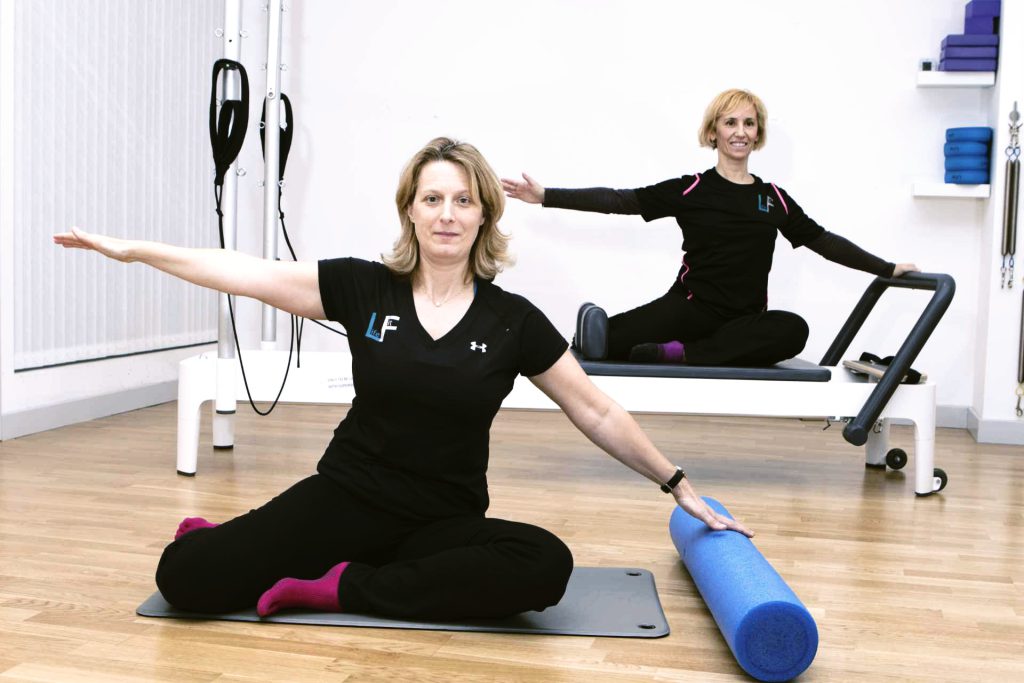By Chartered Physiotherapist and Pilates Instructor, Arlene Bowmaker.
As a Pilates instructor a question I am commonly asked by clients is, ‘Which is better, Pilates mat work or using the Pilates machines?’
Right from the outset let’s clarify that the terminology of ‘machine’ is often considered a faux pas in Pilates terms, as the general consensus is machines have engines and the Pilates ‘machines’ definitely don’t! Instead they rely on you to generate the resistance against the springs and pulleys incorporated into their design.
Traditionally a Pilates Reformer, perhaps arguably the most popular and recognisable of Joseph Pilates inventions was referred to as an apparatus, although nowadays the terminology ‘large equipment’ is commonplace.
Joseph Pilates in addition to being an inventor was a philosopher, author, and teacher. The story goes he invented the reformer using a hospital bed and springs attached to the bedpost to exercise infirm prisoners of World War 2 at an internment camp on the Isle of Man. He christened his method Contrology, as he believed control of the body was key to the mind body conditioning programme.
In the UK Pilates mat work is by far the more popular way to participate in the Pilates method, no coincidence perhaps, because of the space required to house the large pieces of equipment, not to mention the cost involved in purchasing them in the first place. The mat work class scenario allows groups of individuals to perform the exercises together, although here at Life Fit Wellness we promote the value of investing in one to one sessions initially to help you really understand and get to grips with the fundamentals of the technique.
So, if it is just a mat you require is it any wonder the Pilates method delivered as mat work is so popular? Mat work sessions allow you to focus on your body, your breath pattern and use your own body weight as resistance to strengthen the muscles of what Joseph Pilates referred to as the Powerhouse’the abdominals, low back, buttocks and hips.
In order to add variety and challenge to mat work sessions, as well as helping make connections in the body, a variety of small apparatus or props have been developed. Some of these relate to Joseph Pilates original designs such as the magic circle (originally made from the metal rings on beer barrels, so the story goes!) whilst others have evolved from more modern day Pilates practices. Whatever their size, shape or form, their reason for being incorporated into the exercise should be to enhance the client’s understanding of their body, such as which muscles to use and at which tension, and add positively to the overall movement sequence being taught.
However to just do mat work, particularly if large pieces of Pilates equipment are available, means you are missing out on an integral part of the overall Pilates experience.
Sticking with the Reformer as our example, it offers mechanical resistance in the form of springs and pulleys which can elevate your mat work to a new level. It achieves this by adding additional resistance to body weight, or it can support your body weight allowing assistance to achieve a movement pattern that you have not been able to achieve on the mat. Think of it like working with a partner, they can offer guidance and support, or push you that extra bit further!
The Reformer by being a raised platform in design means it is particularly suitable for those who struggle to get on and off the floor and who may have ruled themselves out of participating in a Pilates mat work class. Use of large equipment definitely does not equal advanced Pilates as is the common misconception! Indeed the opposite is often true particularly here in our clinical setting, as using the springs and pulleys assistively mean it is an excellent tool for rehabilitation. Osteoarthritic hips and knees both pre- and post-operatively respond well to the antigravity movement experience that can be afforded to them as the client performs the exercises in a lying position.
However, doing exercises in lying on a Pilates reformer is only part of the story and all positions, particularly those with a functional bias such as kneeling, sitting, and standing are usually incorporated into a workout.
So, can I choose between mat work and large equipment Pilates work?
The answer is a resounding No!
Both offer something different to my personal Pilates experience and understanding of the movement within my body. Ultimately though, it’s neither the mat nor the large equipment that defines your Pilates experience, but your instructor. An experienced instructor will use concise language, visual imagery and informed touch to help you ‘feel’ and explore the movement in your body. They will know what level to work you so you achieve your maximum from your Pilates experience’. when to challenge is desirable, when adaptation of the exercise is essential for your body’s needs, and when to stop!
Our team of Pilates Instructors at Life Fit Wellness are all passionate about Pilates, certified practitioners, and most of us are practising musculosketal (MSK) physiotherapists as well. We consider it our privilege to help you understand your body and inspire you to move like you never dreamed it was possible whether on the mat or on large pieces of Pilates equipment.
Consider your body the most expensive, exquisite piece of equipment ever designed and invest in its wellbeing. Why not consider trying a Pilates mat work class and a Pilates Studio Circuit class (which utilises all pieces of large Pilates equipment including the Reformer, Modified Traps Table, Spine Corrector and Split Pedal Chair) then decide for yourself? If you like Pilates my bet is, like me, you won’t be able to decide” you’ll love both.
Fortunately at Life Fit Wellness you don’t have to choose, our flexible class credit system allows you to participate in both types of classes, perhaps alternating between the types of classes weekly or even making time for a session of both. Hope to see you soon J












